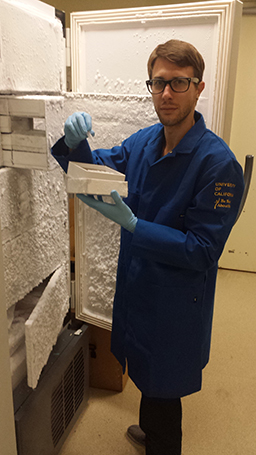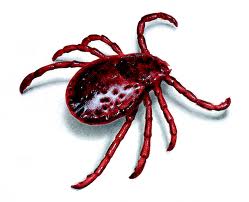 “Lyme is a debilitating illness for which diagnosis is critical for cure.” –Dr. Jerome Bouquet
“Lyme is a debilitating illness for which diagnosis is critical for cure.” –Dr. Jerome Bouquet
Jerome Bouquet, PhD, was recognized in May 2014 as an Emerging Leader in the field of Lyme research. This award recognizes creative ingenuity and novel approaches for the development of better diagnostics and treatment for Lyme disease. The award also carries a $100,000 project grant to fund a new research initiative. Here, Dr. Bouquet talks about his work in the field and his funded project, “Development of a Host Biomarker Assay for the Diagnosis of Acute and Post-Treatment Lyme Disease.”
Q: Earlier this year, you were recognized by Bay Area Lyme Foundation as one of the Emerging Leaders in the field of Lyme disease research. Tell us about your project, what do you hope to accomplish?
A:The project emerged as a result of (1) the lack of sensitive diagnostics for Lyme disease; and (2) the expertise of our laboratory in next generation sequencing. We are developing the unbiased detection of a large number of pathogens. But Lyme disease is trickier, because Borrelia burgdorferi, the bacteria responsible for the disease, is only transiently present in the blood at low titer. So instead of looking for the pathogen, we are examining the human host at a cellular level. How do immune cells respond to the infection and how can we decode and measure their response? That’s what transcriptome profiling is.
Q: How does transcriptome profiling work? What is next-generation sequencing?
A: The transcriptome is the expression of the genome. In other words, the genome is like a book or encyclopedia that contains all the information that is needed to make an individual. The transcriptome is like an excerpt from the book that instructs a cell to perform a certain function — like moving or killing a bacteria. Next generation sequencing (NGS) is a new method of sequencing that allows us to simultaneously decode millions of these sentences (the entirety of the transcriptome at once). By sequencing the transcriptome of immune cells of Lyme disease patients, we are able to decode exactly how those cells respond to the infection. And because immune cells respond differently to different infectious agents, we are able to find out which transcripts are specific to Lyme disease and use those ones as biomarkers.
Q: Are you looking for one biomarker/set of biomarkers that can indicate either an acute or late-stage infection or are you anticipating different biomarkers for each condition?
A: We initially started to look for a set of biomarkers that would differentiate acute Lyme from healthy patients. It turned out that this set was also useful in discriminating Lyme patients up to 6 months after completing the standard course of antibiotics, whether or not the infection was resolved. This discovery is very interesting and potentially means that there could be one assay for all, but we first need to validate if and when do the transcriptome profiles return to “healthy.”
Q: What are the implications for Lyme patients? How would these biomarkers translate into new and improved diagnostics?
A: We are currently designing an assay based on the identified biomarkers that could be used in instruments currently in place in most clinical labs. This assay would be used conjunction with clinical presentation and existing assays to strengthen the diagnosis. But thorough validation of these biomarkers is needed with further testing on new Lyme samples, healthy controls, and other diseases.
Q: Why has it been so difficult to develop more accurate diagnostics for Lyme disease? What are the biggest challenges?
A: Lyme diagnosis is mainly based on clinical presentation and epidemiology: symptoms, exposure to ticks, Lyme endemicity, and seasonality in the region. But the flu-like symptoms of early Lyme disease can resemble many other diseases, the typical bullseye rash is not present in 20-30% of cases, patients may not recall any tick exposure, and Lyme is still little known or recognized in many parts of the country. Moreover, clinical assays are difficult for several reasons. Two-tier serology is the best assay so far, but antibodies can take anywhere from 1 week to 1 month to show up, missing the window of early treatment. There are also cases of patients who remain seronegative despite active infection. Other tests try to directly find the agent of Lyme disease, but the spirochete is present at very low titer in the blood, resulting in low sensitivity.
Q: Have there been any surprises in the work so far?
A: The biggest surprise was the discovery that patients who appeared to have resolved the infection and returned to health, still showed marked changes in their transcriptome with a strong immune response after completion of the standard course of treatment. We are not sure what to make of this finding as it has not been tested or reported for any other illnesses before. It might be linked to the development of post-treatment Lyme disease (PTLD) in certain patients, but this is just a hypothesis so far.
Q: You have spent the past two years working with Dr. Chiu at UCSF focusing on infectious diseases including Lyme and the Lyme-like Southern Tick-Associated Rash Illness (STARI). Tell us about some of the other tick-borne disease-related research.
A: We are working with the California Department of Public Health and the CDC to discover previously unknown agents causing Lyme-like diseases. A better knowledge of pathogens found in ticks will enable a better diagnosis of Lyme disease and more appropriate treatments in cases of co-infections. For example, STARI is a tick-borne disease with a skin rash looking like a bullseye, but is transmitted by the Amblyomma tick (different from the Ixodes tick carrying Borrelia). Even though the disease has been described since the 70s, we still do not know the agent. Preliminary investigation found a novel virus in one Amblyomma tick, but nothing that would indicate a probable candidate as the causal agent. By applying deep sequencing to samples collected from STARI patients, we hope to identify sequences related to known or novel organisms.
Q: Tell us more about how you ended up focusing on Lyme disease?
A: Andrea Swei, now assistant professor at SFSU, had done her PhD on Lyme disease ecology at UC Berkeley and naturally started a few projects on tick-borne diseases as a postdoc in Charles Chiu’s lab. As she moved on to her new position, I took over the human transcriptome project, a technique that I wanted to develop for a number of diseases when I joined the lab. It is really exciting to develop this novel approach for Lyme disease because unlike other diseases there is a real need for better laboratory diagnostics and this study will have a direct application in real life.
Q: Do you have any personal connections to Lyme disease? Friend or family member who might have been affected (or infected)?
A: It is only since I started working on Lyme and telling people about my work that I learned how many around me were familiar with the disease. Lyme disease is not thought to be as prevalent in France as it is in the US. Still, my mom – a fervent hiker – has been tick-screening her dog regularly for years now. Friends also have started telling me of relatives and acquaintances with tick-borne diseases. I think that one of our next steps will be to apply our technique to other tick-borne diseases.
Q: Knowing what you do about Lyme disease, what do you think is most important for the general public to understand about Lyme?
 A: Lyme is a debilitating illness for which prevention is better than cure. I think that the work done at the Bay Area Lyme foundation is crucial. Awareness of the disease, learning how to protect yourself, doing tick checks, and keeping the ticks for lab testing are the most important aspects to know about Lyme, in my opinion.
A: Lyme is a debilitating illness for which prevention is better than cure. I think that the work done at the Bay Area Lyme foundation is crucial. Awareness of the disease, learning how to protect yourself, doing tick checks, and keeping the ticks for lab testing are the most important aspects to know about Lyme, in my opinion.
Q: What do you know now that you wish someone had told you when you were first starting your research career? How might you advise someone else just getting started?
A: I wish someone told me to learn more about computer science. Bioinformatics is an important part of my work and nowadays it is becoming increasingly relevant in all fields of biology and medicine. So my advice to someone starting research would be: to dig deeper into computational biology, because not only will it be useful with analyze large datasets, but it will also be easily transferable to work outside of academia.
Q: You are originally from France and yet seem entirely at ease here in California. What have you enjoyed discovering here in the Bay area? What do you miss most from home?
A: I am originally from Paris and I moved here about 1.5, almost 2, years ago. I am really enjoying my life here in California. I love the weather, the great outdoors, and the positivity and creativity of the Bay Area. I thought I would have been missing French food, but actually not at all. I am thrilled by the fusion food scene here, the farmer’s markets, and the vineyards.